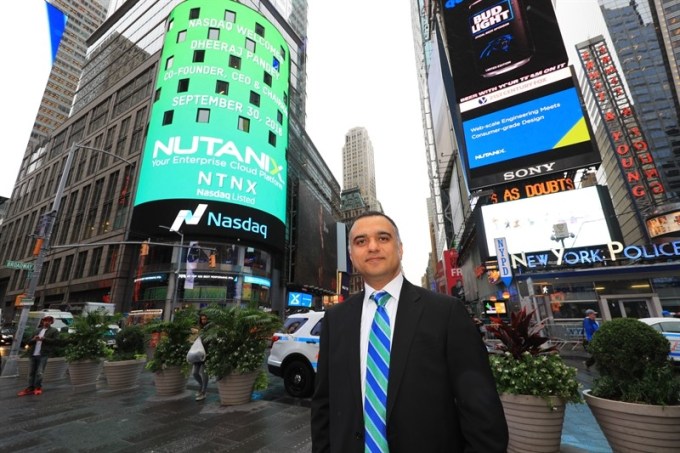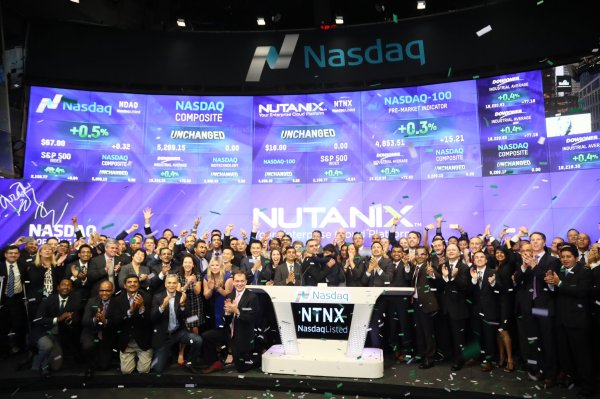Bringing a startup from idea to IPO isn’t an easy task, but if you can build something successful, one major milestone is to go public. Before your Nasdaq debut, however, there’s a major step — building a deck and taking it on the road for investors.
Cloud computing company Nutanix went public in 2016, so we spoke to CEO Dheeraj Pandey and CFO Duston Williams, both of whom were with the company for the big event, to learn about how a company should define itself for investors as it seeks to go public.
Who are you?
Building a roadshow deck is an exercise in communications as founders attempt to carefully lay out their company’s core purpose and how they built it, along with their ethics, aspirations, financials and value proposition. In a nutshell, an effective roadshow deck summarizes who you are, what you stand for and why your company will make a good investment.
CEO Pandey says that in addition to investment bank Goldman Sachs, a number of people from the company helped craft the presentation. “Fifteen people across different functions were involved in building the deck. That included product and marketing, to finance and corporate communications, to legal. I think there were at least six different departments,” he said.
Pandey recalls it as an exciting time as they hashed out the contents for the deck. “We all have very fond memories of how the process brought us together. I think that’s probably the core of everything because it makes you go back to the basics, which is the why and the how and the what of your company,” he said.
For him, the deck was an opportunity to help define the long-term viability of the company. He said he wanted to connect the dots between things like customer service, customer support and net promoter score to show how these elements led to customer and company success over the long haul. “I think you have to go and tell that story, and then people realize that this is not just a one-off product,” he said.
It’s more about finance than tech
Pandey said the big challenge in this exercise was that it wasn’t about selling the product, something they had been doing since 2011; it was about being more focused on selling investors on the financial upside of the company, and that shift in audience had a big impact on the content decisions they made along the way.
CFO Williams says it’s important to take the technical knowledge of your financial audience into account when building a roadshow deck, especially with a product as complex as Nutanix. “The challenge in putting these types of presentations together, specifically for an IPO roadshow, is that the decision makers or the portfolio managers are, for the most part, generalists. They [may] know technology, but they don’t know it at a deep level.”
That means you have to balance the level of technical detail in the presentation. “The challenge always in a deck like this is how do you keep it simple, but still get the message across as far as your level of differentiation, the size of the opportunity, why you ultimately win, why it’s actually a good investment for the long term — and things like that.”
Iterate, then iterate some more
Building the deck was a long process, bringing in lots of stakeholders, finding that right balance between philosophy, finance and technology and telling a story that captured investors’ imaginations. In fact, they say they went through more than 100 iterations to get to the final version.
Williams says the investment bankers who lead IPOs also have a seat at the table and can help find the right balance. “When you’re putting a deck or a presentation like this together, you’ve obviously got good investment bankers [with you] who understand the business, and, more importantly, understand investors and what investors either like to see or what they can absorb, and that’s a huge part of this,” he said.
When Nutanix went public in 2016, it was a very tough IPO environment at the time, which added to the challenge of creating a good deck. “We were one of the first companies to go public after that terrible period there, so there wasn’t an environment where investors were just willing to accept [what we presented],” said Williams. “So we had to work a little extra hard on the message.”
Details matter

Nutanix CEO Dheeraj Pandey in New York City the day of his company’s IPO
Building a roadshow deck is part of the legal process of going public, so Pandey said founders have to make sure they have their facts right. Some might assume that it’s not much different from creating a pitch deck for private investors, but he said there was far more legal scrutiny involved when presenting for the purpose of becoming a public company.
“We had a data room and paid close attention to the details and data and numbers. It was way more rigorous than the private rounds of funding, which basically are just one person presenting in a closed-room setup,” said Pandey. “It’s a very different process when you have to go to the public investors and deal with SEC and FINRA and all these other things.”
Updates and more updates
Williams said there was yet another twist to this process; some companies also produce a high-quality video, which added another layer of complexity. “The roadshow deck itself is one piece…today, companies do a pretty sophisticated recording that goes out to the investment community and it gets published on the web,” he said.
The company didn’t have to go out when it did, so it had the luxury of time. According to Williams, they ended up producing three different videos because the roadshow got pushed back a couple of times. When you end up pulling back as they did, information can get out of date and you need to go through it again, he said.
“What Wall Street wants to know is who are the people behind the story — not just the story itself — and that’s where the video comes in. I think we were sticklers for accuracy and making sure [everything was correct] because the company was growing quarter by quarter quite a bit back in the day, so any data that you had in January was stale by the time, you know, September came,” Pandey said.
All that work
Williams says one of the true ironies here is that after all the work that they put into the deck when they went on the road, they didn’t have to go through the deck with investors at all unless it was a large group.
“The only time that we really formally presented the deck while we were on the road is in the bigger lunch meetings or breakfast meetings or something like that where you have lots of investors in the room that might not be as familiar with us. So we kicked off those meetings and ran through the deck quickly in a more formal manner,” he said.
The larger investors referenced the deck, but they didn’t present formally, instead answering investor questions. Williams has been involved in three IPOs and he says the length of the roadshow varies, but typically takes seven to nine days. For Nutanix, they went from the West Coast to the East Coast, starting in LA and finishing in Boston.
When your moment comes, you need to put the required time into the process to create a deck that will convince investors, especially the ones who don’t know you well, that you are worth their investment. The deck may only be a piece of that, but you surely want to get it right and define your company on your terms.
